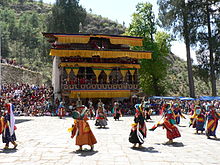|
Tshechu  A tshechu (Dzongkha: ཚེས་བཅུ།, literally "tenth day") is any of the annual religious Bhutanese festivals held in each district or dzongkhag of Bhutan on the tenth day of a month of the lunar Tibetan calendar. The month depends on the place. Tshechus are religious festivals of the Drukpa Lineage of the Kagyu school of Tibetan Buddhism. Tshechus are large social gatherings, which perform the function of social bonding among people of remote and spread-out villages. Large markets also congregate at the fair locations, leading to brisk commerce.[1] The Thimphu tshechu and the Paro tshechu are among the biggest of the tshechus in terms of participation and audience. They are related to traditions in other branches of Himalayan Buddhism, many of which have been banned in Tibet.[2] Tshechu traditionsThe focal point of the tshechus are Cham dances. These costumed, masked dances typically are moral vignettes, or based on incidents from the life of the 9th century Nyingma teacher Padmasambhava and other saints.[1] Typically, monks perform unmasked in certain group dances, including the Black Hat dance, while laymen perform masked, in largely different plays. The monks are generally very precise in their movement, while some roles played by laymen involve considerable athleticism (such as the leaping dog shown below, who repeats this move over and over again). Groups of women perform songs, with limited dance movements, in between the plays. Most tshechus also feature the unfurling of a thongdrel - a large appliqué thangka typically depicting a seated Padmasambhava surrounded by holy beings, the mere viewing of which is said to cleanse the viewer of sin. The thongdrel is raised before dawn and rolled down by morning. Because tshechus depend on the availability of masked dancers, registered dancers are subject to fine if they refuse to perform during festivals.[3] History of Tshechus Padmasambhava, the great scholar, visited Tibet and Bhutan in the 8th century and 9th century. He used to convert opponents of Buddhism by performing rites, reciting mantras and finally performing a dance of subjugation to conquer local spirits and gods. He visited Bhutan to aid the dying king Sindhu Raja. Padmasambhava performed a series of such dances in the Bumthang Valley to restore the health of the king. The grateful king helped spread Buddhism in Bhutan. Padmasambhava organized the first tshechu in Bumthang, where the eight manifestations of Padmasambhava were presented through eight forms of dances. These became the Cham dances depicting the glory of Padmasambhava. ScheduleThe dance schedule for each day of the four-day festival is set out and generally consists of the following dances.
The last day of the four-day festival also marks the unfurling of the Thongdrel, a very large scroll painting or thangka, which is unfurled with intense religious fervour, early in the morning. This painting measuring 30 metres (98 ft)×45 metres (148 ft) has the images of Padmasambhava at the centre flanked by his two consorts and also his eight incarnations. Devotees who gather to witness this occasion offer obeisance in front of the Thongdrel seeking blessings. Folk dances are performed on the occasion. Before sunrise, the painting is rolled up and kept in the Dzong before it is displayed again one year later.[4] List of tshechusBelow is a list of major tshechus in Bhutan, along with their 2011 dates. Dates in other years will vary.
In popular cultureThe Bhutanese film Travellers and Magicians is set among a group of travellers, most of whom are going to the Thimphu tshechu. See also
References
|
Portal di Ensiklopedia Dunia